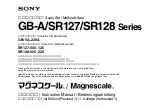
M E A S U R E M E N T S Y S T E M S I N T E R N A T I O N A L
Page 28
MSI-4260
Port-A-Weigh
•
User Guide
Setting the Transmitter Address
In order to allow the formation of up
to 1024 unique Transmitter-Receiver
relationships, the transmitter’s ad-
dress may be selected using internal
DIP switches as shown. The switches
are accessed by removing the DIP-
switch access cover.
Note:
If the switch is on, the address
line is connected to ground,
otherwise it is
fl
oating. The
receiver’s address must match
in order for the units to com-
municate.
MSI supplies the transmitter and receiver as a matched set with the DIP switches already
con
fi
gured. A replacement RFRC will only need to have the transmitter DIP switches set. To
change the DIP switch in the receiver requires disassembly of the crane scale front casting.
Note:
Due to different DIP switch styles, the receiver DIP switch appears opposite to that of
the transmitter. On the receiver, the OFF position is on the right, and the ON position
is on the left.
Contension Considerations
It is important to understand that only one transmitter at a time can be
activated within a reception area. While the transmitted signal consists
of encoded digital data, only one carrier of any frequency can occupy
airspace without contention at any given time.
Battery Replacement
The remote unit utilizes a CR-2032 Button Lithium Cell. In normal use
it will provide 1-2 years of operation. Access for replacement is accom-
plished by removing the battery access cover by pressing down
fi
rmly on
the label area and sliding it off. Once the unit is open, remove the battery
by sliding it from beneath the holder. Replace the cell with the same type
while observing the polarity shown.
RF Remote Control FCC Statement
Instruction to the User
This equipment has been tested and found to comply with the limits for a class B digital
device, pursuant to Part 15 of the FCC Rules. These limits are designed to provide reason-
able protection against harmful interference in a residential installation. This equipment
generates, uses and can radiate radio frequency energy and communications. However, there
is no guarantee that interference will not occur in a particular installation. If this equipment
does cause harmful interference to radio or television reception, which can be determined by
turning the equipment off and on, the user is encouraged to try to correct the interference by
one or more of the following measures: Reorient or relocate the receiving antenna. Increase
the separation between the equipment and receiver. Connect the equipment into an outlet
on a circuit different from that to which the receiver is connected. Consult the dealer or an
experienced radio/TV technician for help.







































